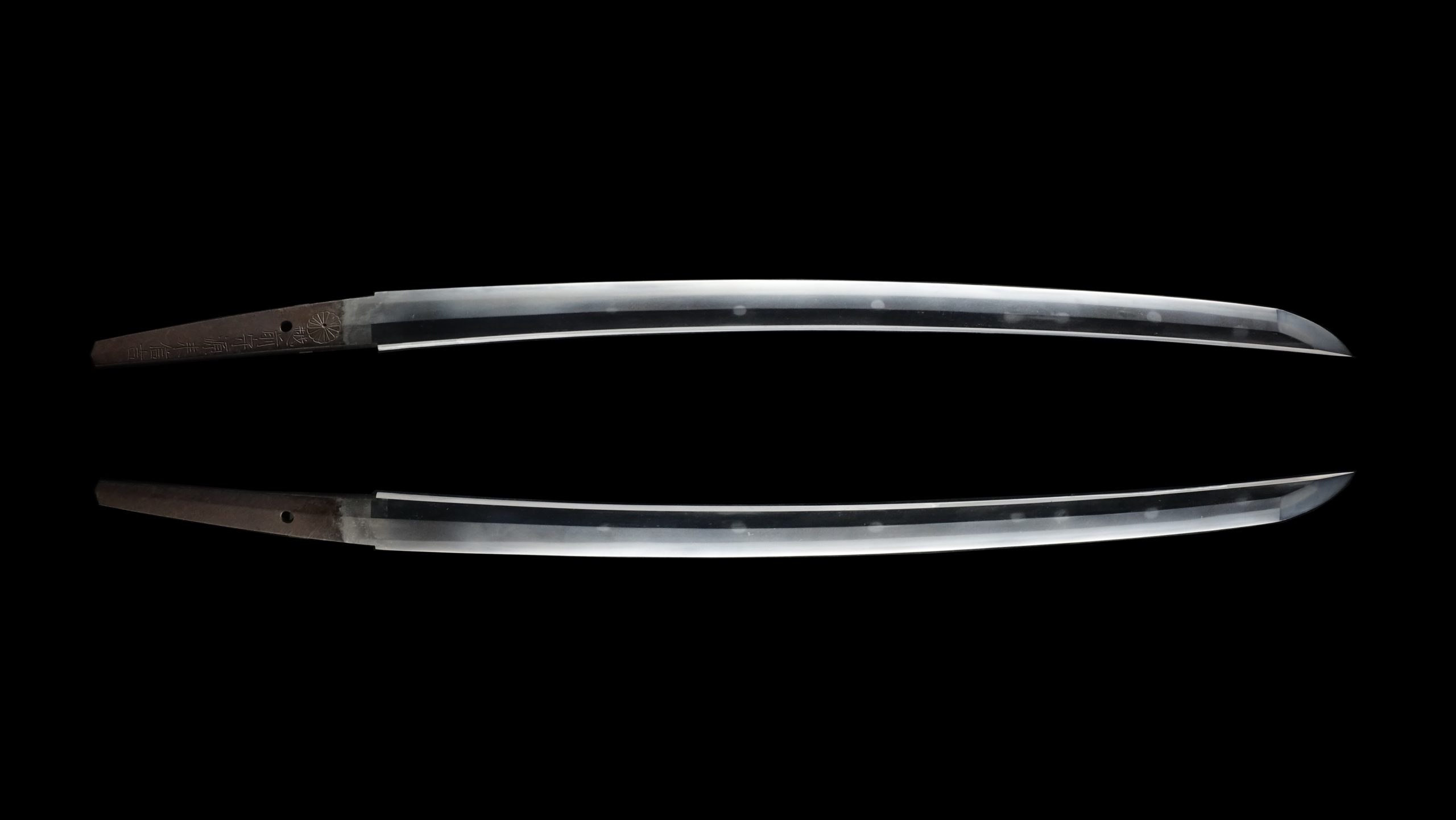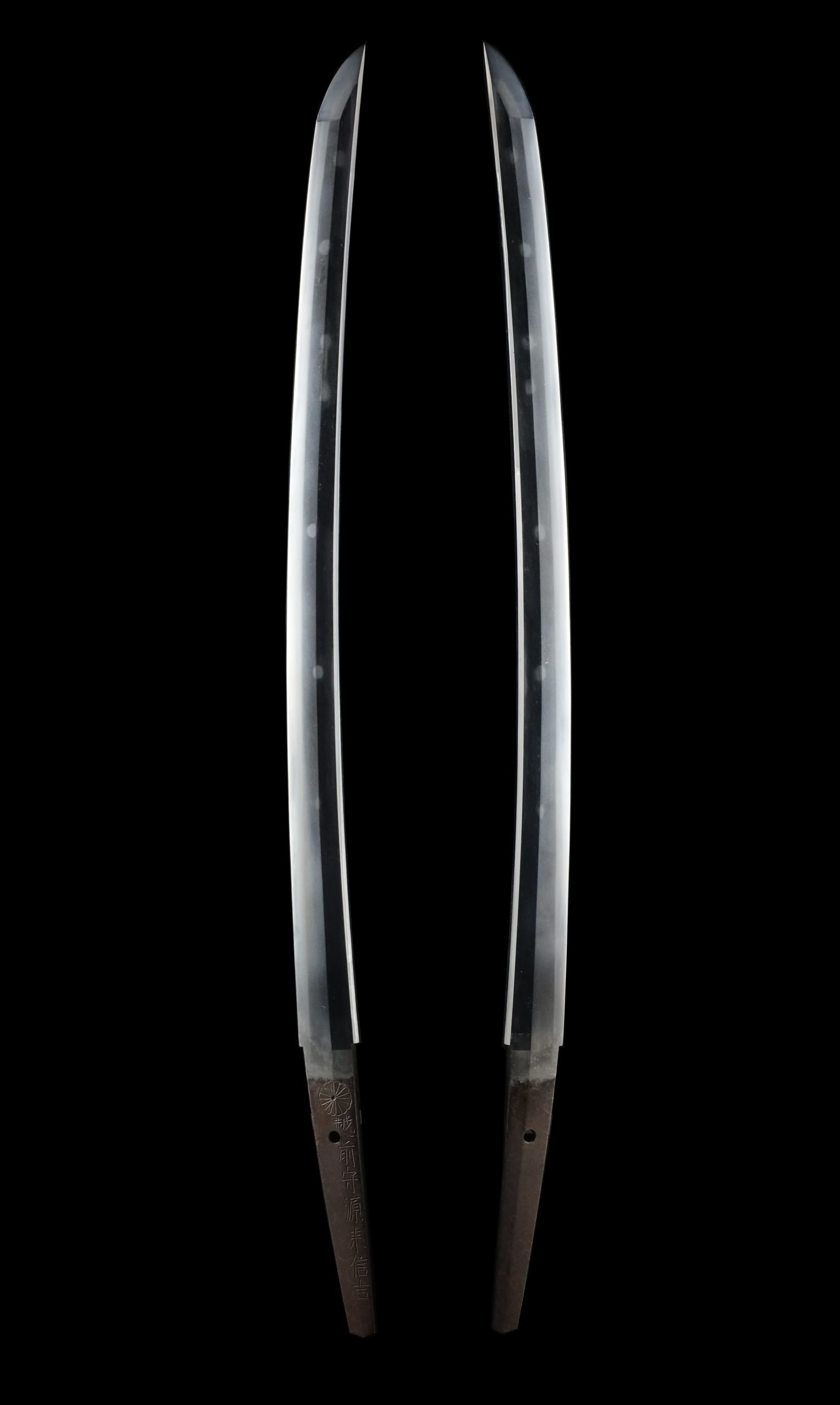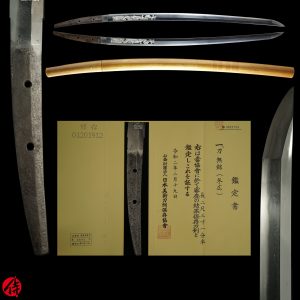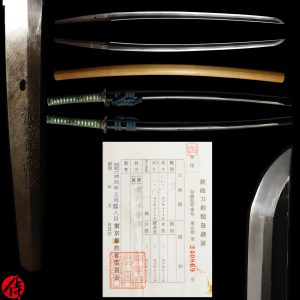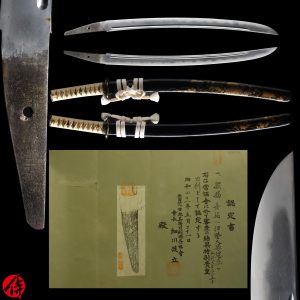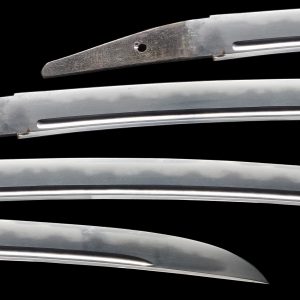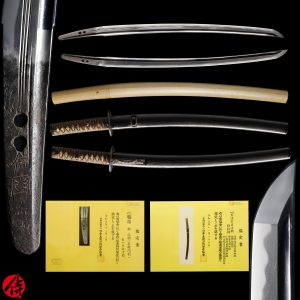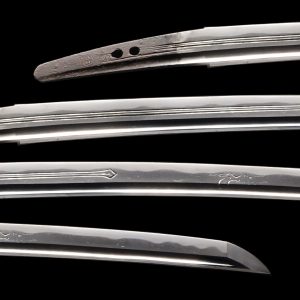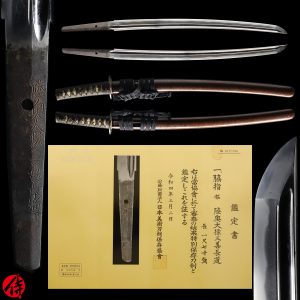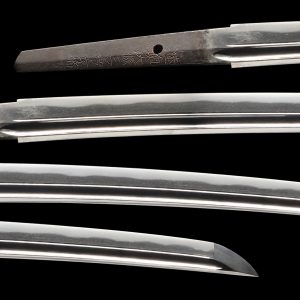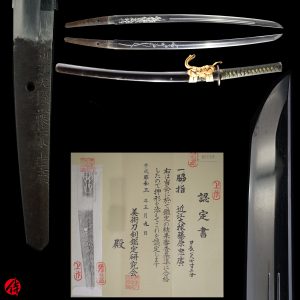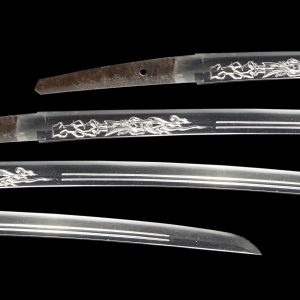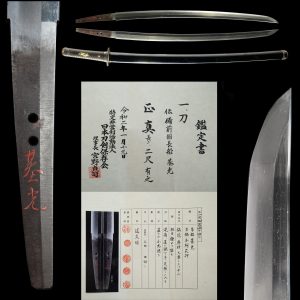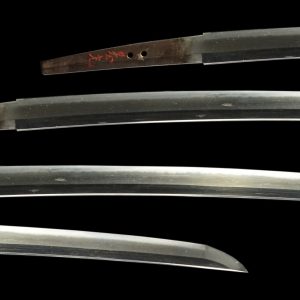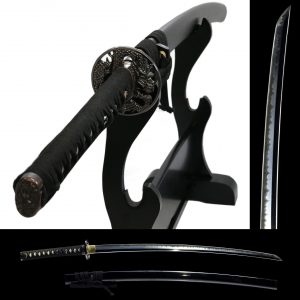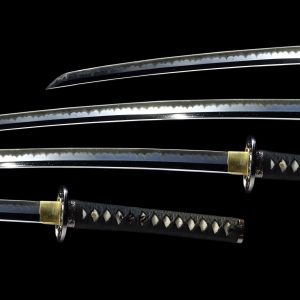Antique Japanese Sword Wakizashi Signed by Nobuyoshi with NBTHK Tokubetsu Hozon Certificate
【Description】
Echizen no Kami Rai Minamoto Nobuyoshi(越前守源信吉) was the third son of the first-gen Shinano Kami Nobuyoshi(信濃守信吉), who belonged to Mishina school.
Mishina school’s founder was originally from Mino province, exclusively forging blades for Shingen Takeda, a famous feudal lord. Later on, he moved to Kyoto by bringing his four sons and founded his school in Kyoto. The first-gen Shinano Kami Nobuyoshi(信濃守信吉) was known as one of the skilled swordsmiths. He also became one of Kyoto Gokaji(京都五鍛冶), five prestigious swordsmiths forging in Kyoto in the early Edo period.
The first-gen Shinano Kami Nobuyoshi was allowed to inscribe a chrysanthemum emblem, which is the symbol of the Japanese emperor. His sword-forging technique was so great that the emperor licensed him to use this emblem, which was quite honorable for any swordsmiths. Echizen no Kami Rai Minamoto Nobuyoshi was also allowed to inscribe a chrysanthemum emblem.
Echizen no Kami Rai Minamoto Nobuyoshi is said to have forged this blade during the early Edo period(Late 17th century). He mainly created his work in the Setsu area in Osaka, although he initially started his career as one of Mishina’s school swordsmiths in Kyoto. Among other swordsmiths who had Nobuyoshi in their maker’s name, this Nobuyoshi was known as the most skilled one.
This blade has interesting seven dots on each side of the blade, which was intentionally made by Nobuyoshi. It is said that the design was inspired by the Big Dipper.
In Japan, Big Dipper is considered secrete symbol or god in some Buddhism branches. It is called Myoken Bosatsu, Buddha of stars. The Big Dipper is regarded as the center of the universe with the highest importance among other stars in this religion.
It is believed that Big Dipper’s existence keeps you safe, healthy and prevents you from getting sick or encountering any disasters. In medieval times, this god was treated as a war god that brought winning to Samurai as it was believed this god brought a lot of good luck. We believe Nobuyoshi might have been requested to make these dots by the Samurai who ordered it. It is extremely rare to find the blade with this kind of Big Dipper design.
This blade has a Tokubetsu Hozon certificate issued by NBTHK. This authentication paper was only given to Japanese swords, especially worth preserving by Nihon Bijutsu Touken Hozon Kyokai(the Society for the Preservation of the Japan Art Sword). This sword has beautiful Suguha(straight tempering line) and Jigane. It comes with a beautifully black lacquered scabbard with gorgeous Tsuba.
【 Blade】
Cutting Edge Length(Nagasa):54.8 cm ( 21.6 inches)
Curvature(Sori): 1.3 cm(0.51 inches)


Hamon:
The crystalline structure which forms along the cutting edge of a blade as a result of the hardening process
Jimon(Jihada):
visible steel surface pattern created by folding and hammering during forging process
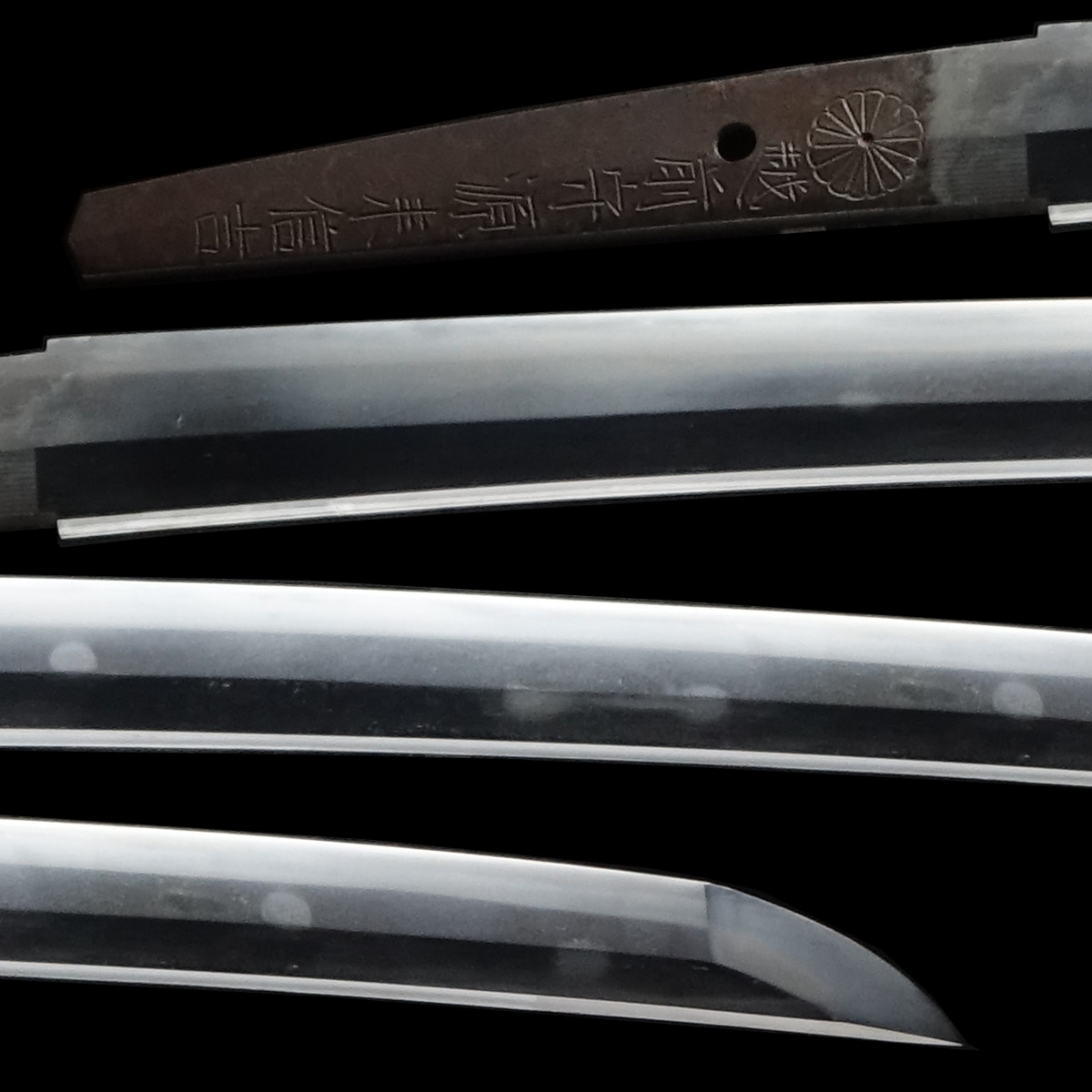
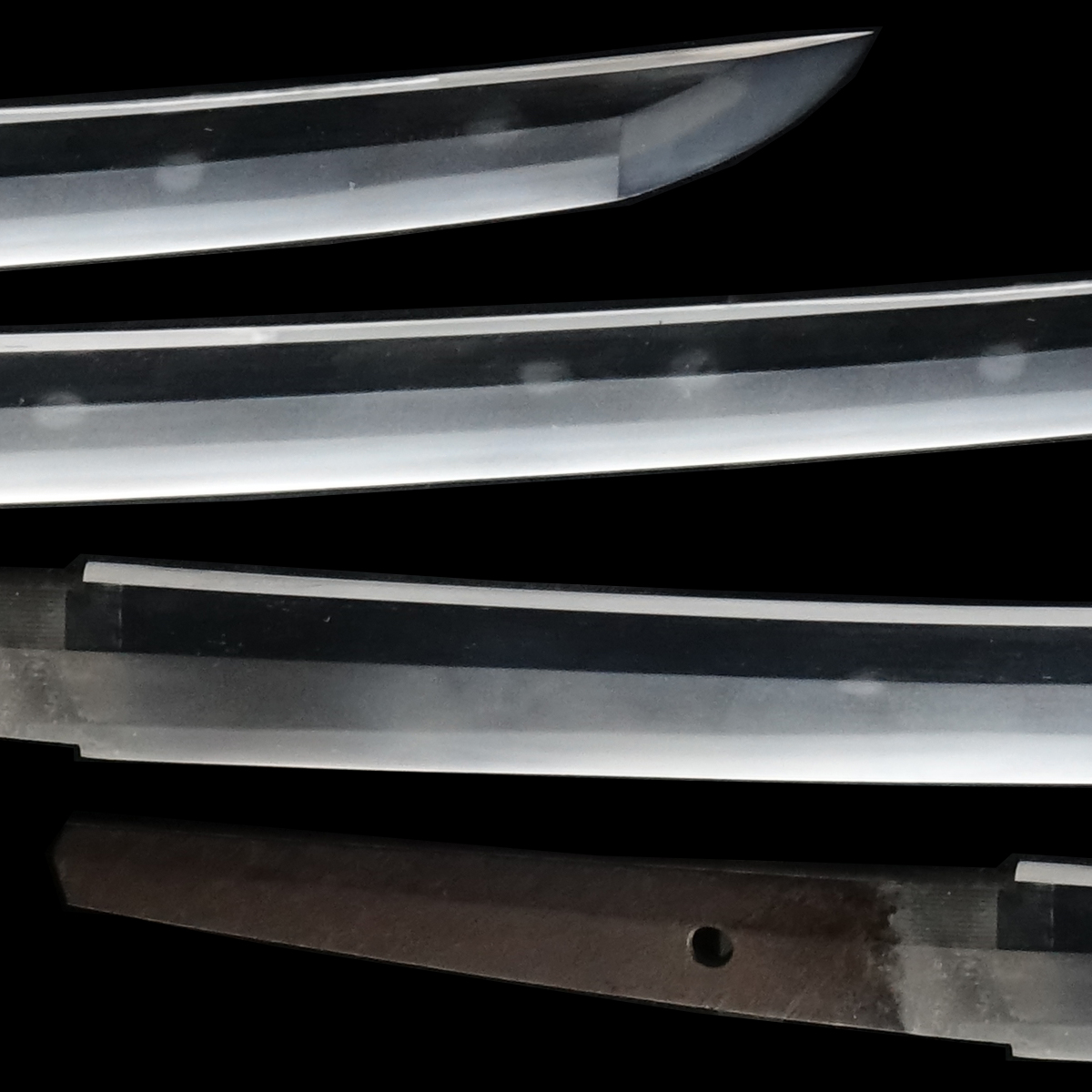
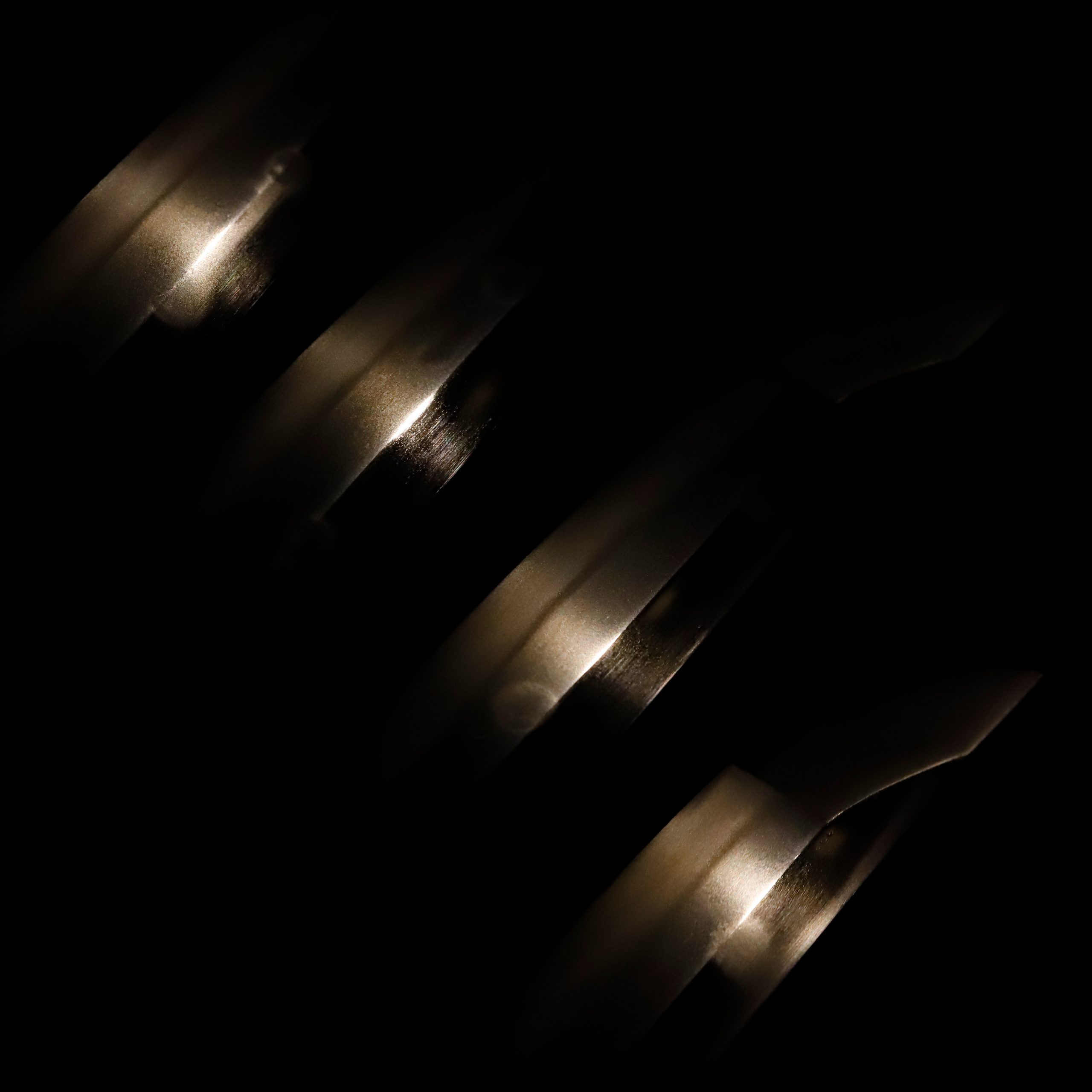
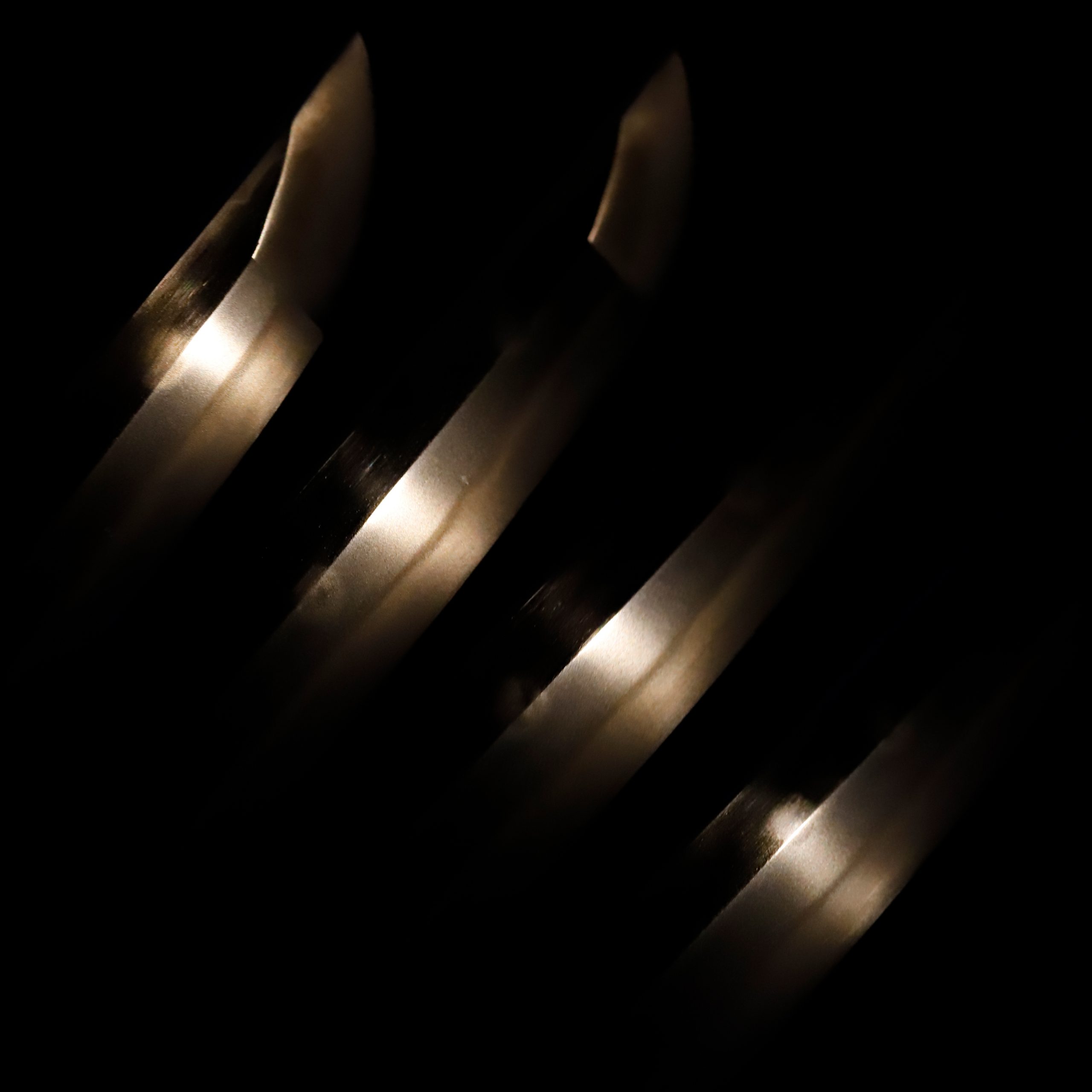
Nakago:Nakago is the tang of the Japanese sword.
Japanese swordsmiths left the black rust on the tang on purpose to prevent red rust while the tang is in its handle. And the discoloration of the tang was created over time, which is a great indicator for a Japanese sword specialist to estimate when the sword was forged.
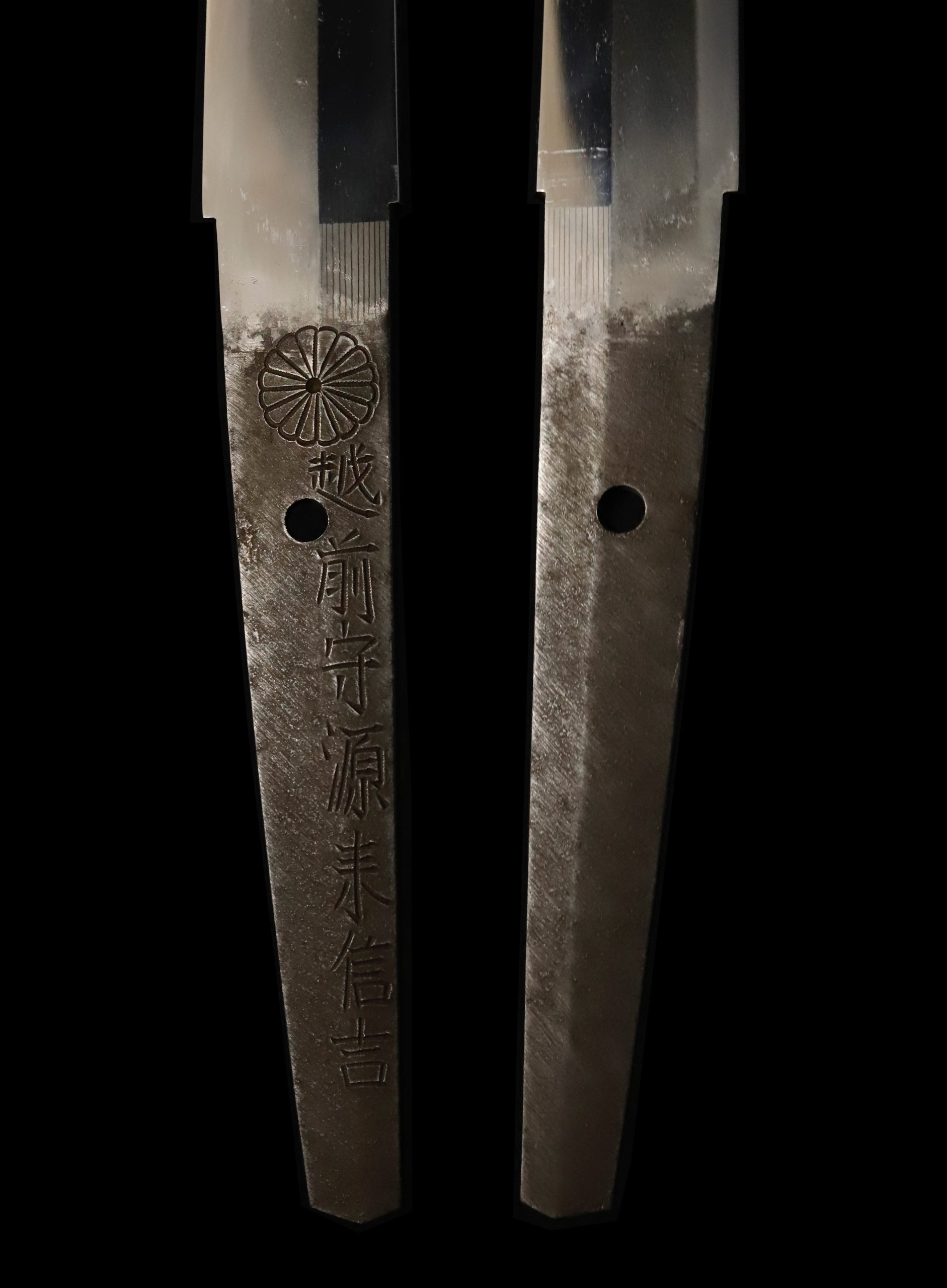
Koshirae: Koshirae is the mounting of the Japanese sword. There are several parts that consist of Koshirae such as Saya(Sabbard), Tsuka( Handle), Tsuba(Handguard).

Fuchi-Kashira:A pair of matching sword fittings that cover the upper and bottom parts of its sword hilt.
The Japanese apricot blossom pattern decorates this Fuchi Kashira. It looks petals were initially colored with gold. This flower begins to bloom in winter that snow covers its tree. Therefore, people thought it tells the arrival of spring. This plant motif has been appreciated for a long time ago in Japan. People enjoy its adorable petal shape and scent, gracefully branched tree, and compose many poems. As it comes out in the cold season, it symbolizes the power of perseverance and vitality.
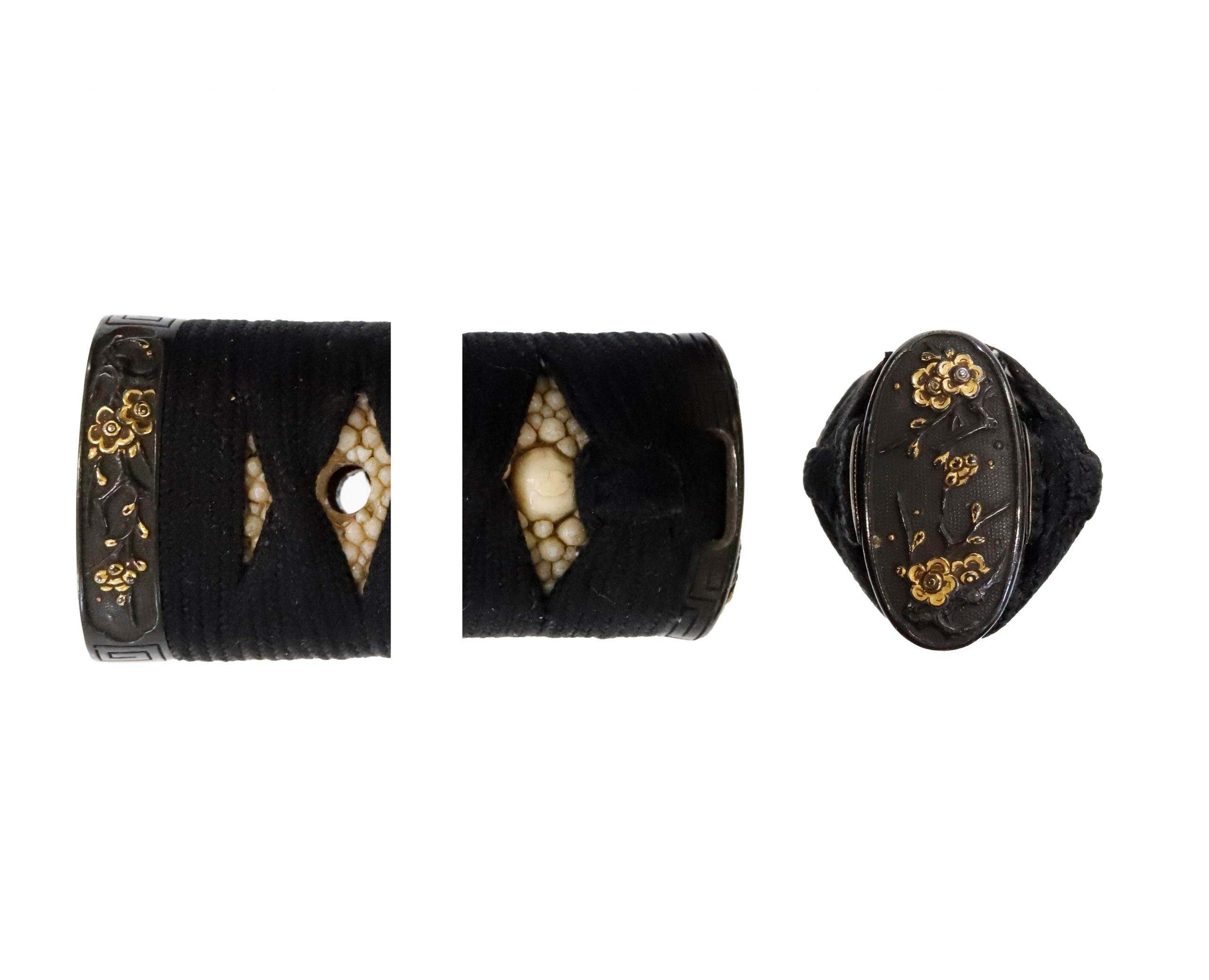
Tsuka and Menuki:Tsuka is the handle of the Japanese sword and Menuki is its decoration.
A small white bird is peeking through the gaps of Tsukamaki thread. This bird’s head to the neck are white, and its body part remains the color of copper. Probably, the white paint flaked off due to aging. Or, different types of materials were intentionally used for each part of this bird.

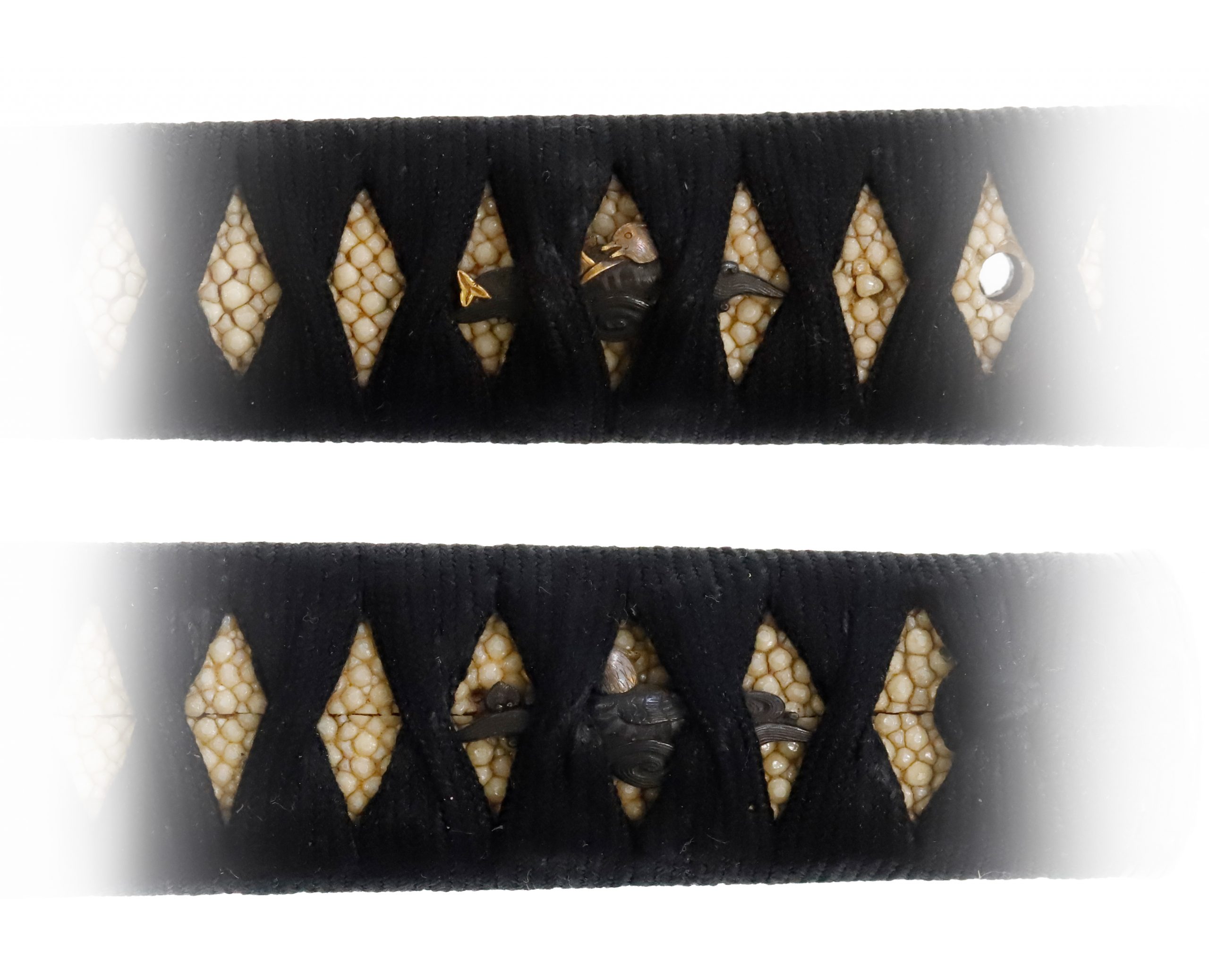
Tsuba and Habaki:Tsuba is the handguard for the Japanese Sword and Habaki is the equipment to make the blade not touch its scabbard inside. It prevents the blade from getting rusty and chipped.
Chrysanthemum petal-shaped Tsuba that has a Kozuka hole. The Society recognizes this Tsuba for Preservation of Japanese Art Swords, which is known as NBTHK. According to its certificate, it is Umetada-style Tsuba. Umetada school was famous for metalworking and swordsmiths in Kyoto. The first of Umetada school was Myouju Umetada, his father, and he worked for the Ashikaga Shogunate family as a metal worker.
This Tsuba is made from brass, and its surface has been finished with the Amidayasuri (阿弥陀鑢) technique. It is a type of decorative carving technique that is used for the ground of the Tsuba. Thin lines are engraved with a file, and these lines are radiated from the center of the Tsuba. As this design looks similar to the halo of Amida Nyorai (阿弥陀如来, Amitabha Tathagata), this technique was named Amida-Yasuri.
The chrysanthemum is a kind of noble motif. A long time ago, this flower was used as a medicine for obtaining a long life in China, and it was brought to Japan with this thought in the Nara period (648-781). Chrysanthemum symbolizes fall, and people appreciate it very much since ancient times. As its petals form radially, the chrysanthemum has been likened to the sun. That is why this flower pattern is treated as the symbol of perpetual youth and longevity or good health. It has also been used as the crest of the emperor and the royal family in Japan. So it is well-known as an aristocratic pattern.

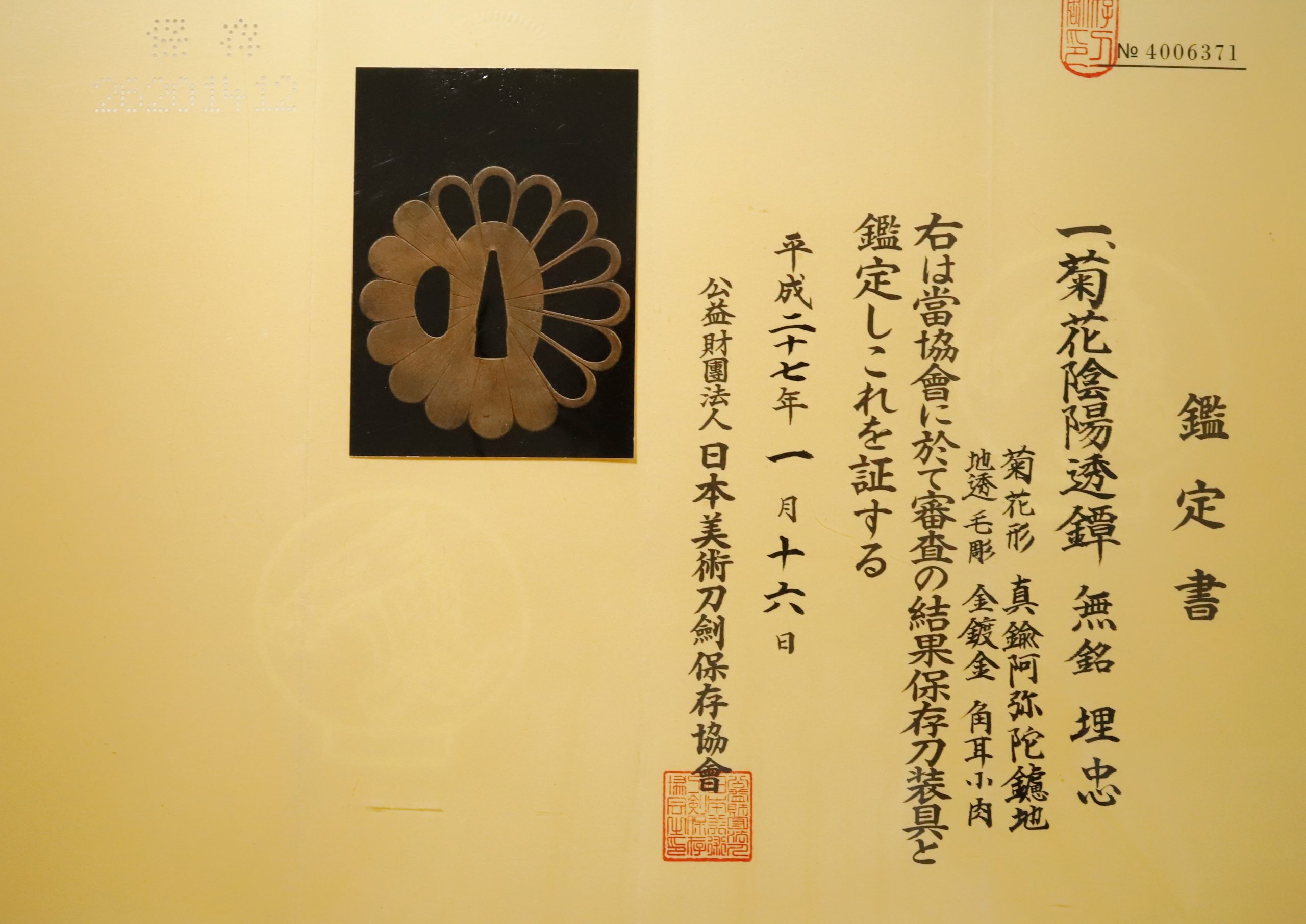
Saya: Saya is the scabbard for the Japanese sword.
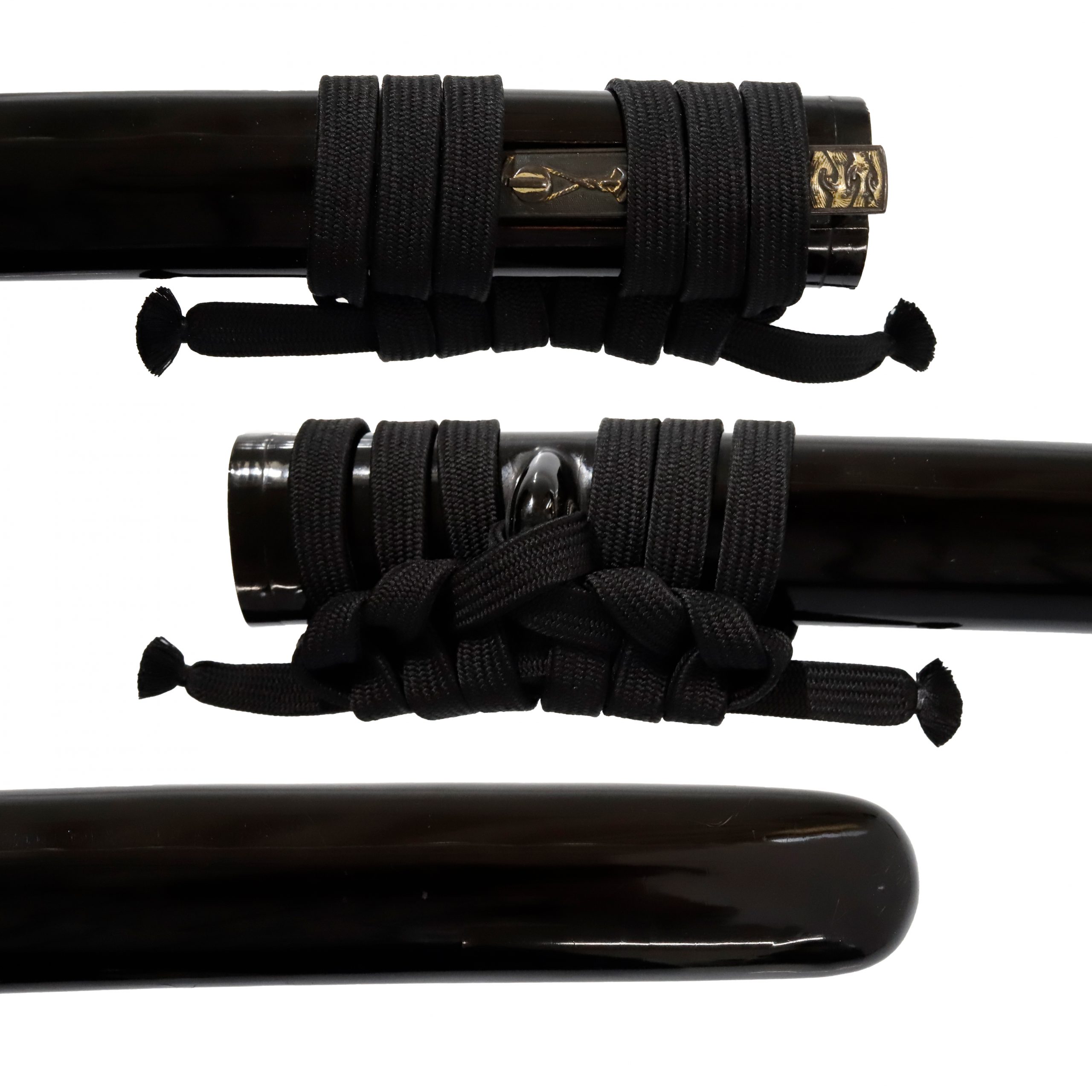
Kozuka:Kozuka is a small knife stored in Kozuka Hitsu(groove of the sheath of the Japanese sword).
Probably, a scene of dropping an anchor from a ship into the water is depicted. As Japan is an island country, the shipping industry has been thriving. Especially in seaside areas, various motifs related to voyage-such as a ship, anchor, or raft, were often used for family crests. We could imagine that Samurais have preferred to apply these motifs to obtain the powerful strength like an anchor that can stop the movement of a huge ship.
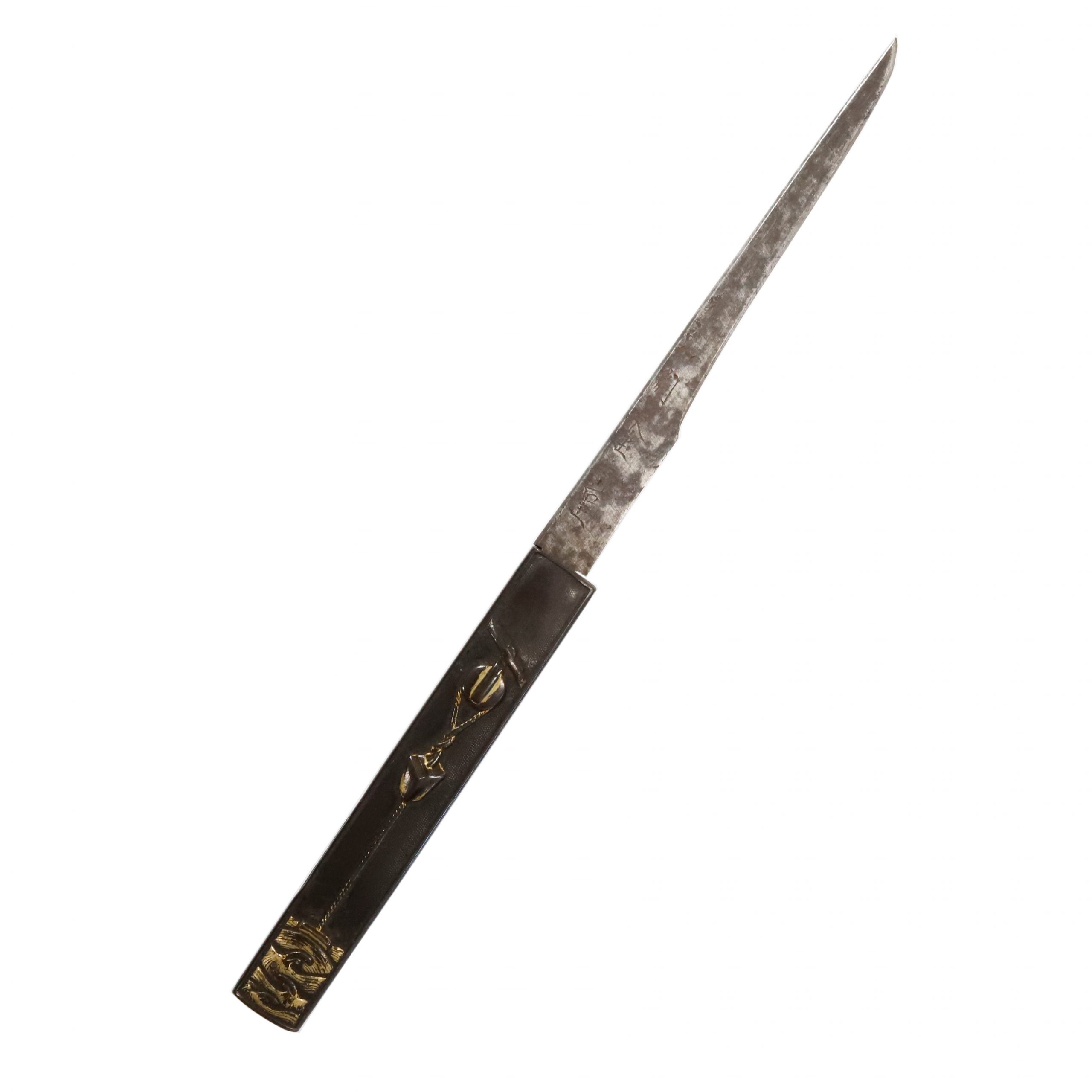
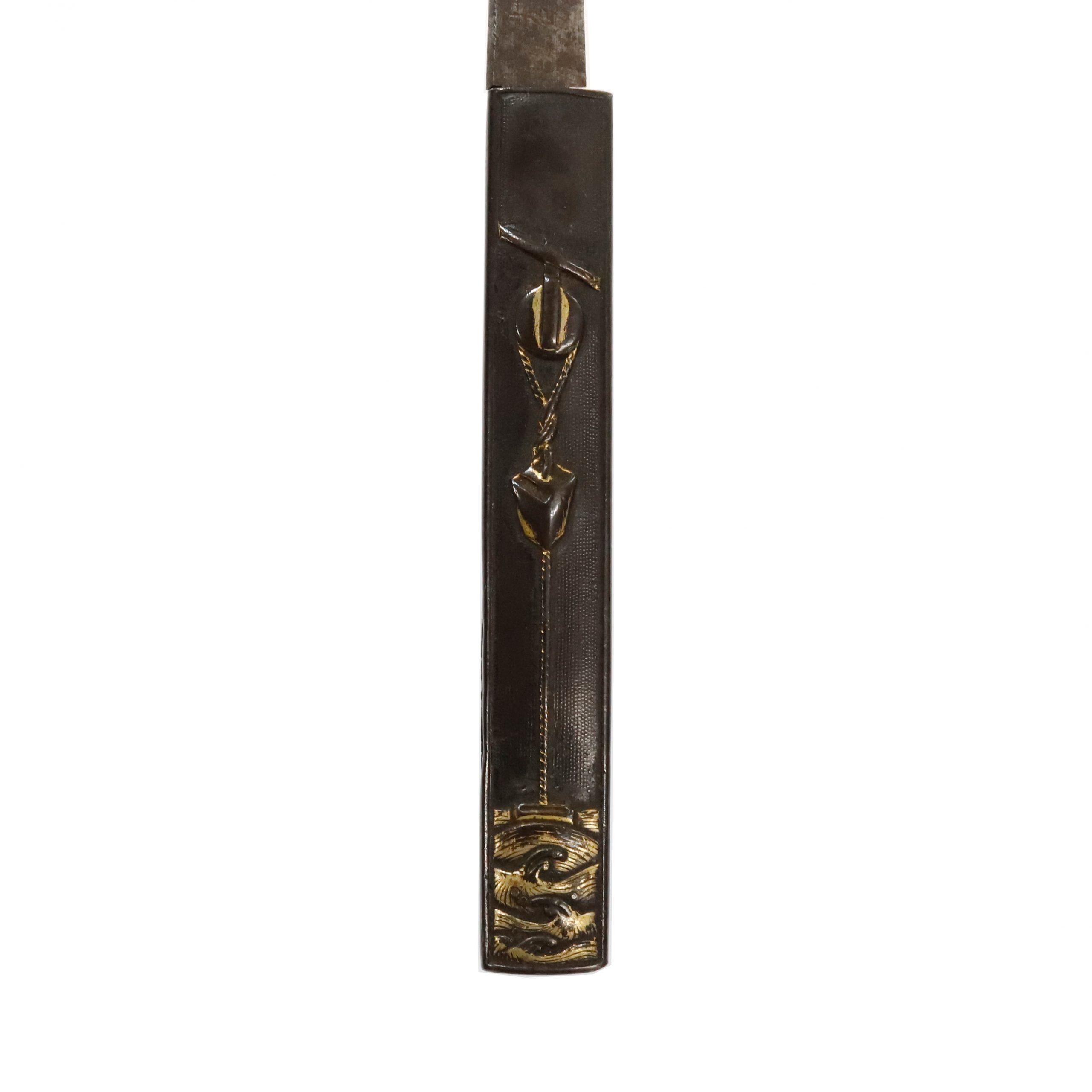
Authentication Paper:NBTHK TOKUBETSU Hozon Certificate for the blade
NBTHK, also known as Nihon Bijutsu Touken Hozon Kyokai (the Society for the Preservation of the Japan Art Sword), is one of the oldest Japanese sword appraising organizations in modern-day Japan. They authenticated the blade on August 20th in the 30th year of Heisei(2018). They appraised it as Tokubetsu Hozon Touken, the blade especially worth preserving for Japanese society. The purchaser will receive this original certificate as well. We can also translate what is written into English and make a PDF file for your record if you request.
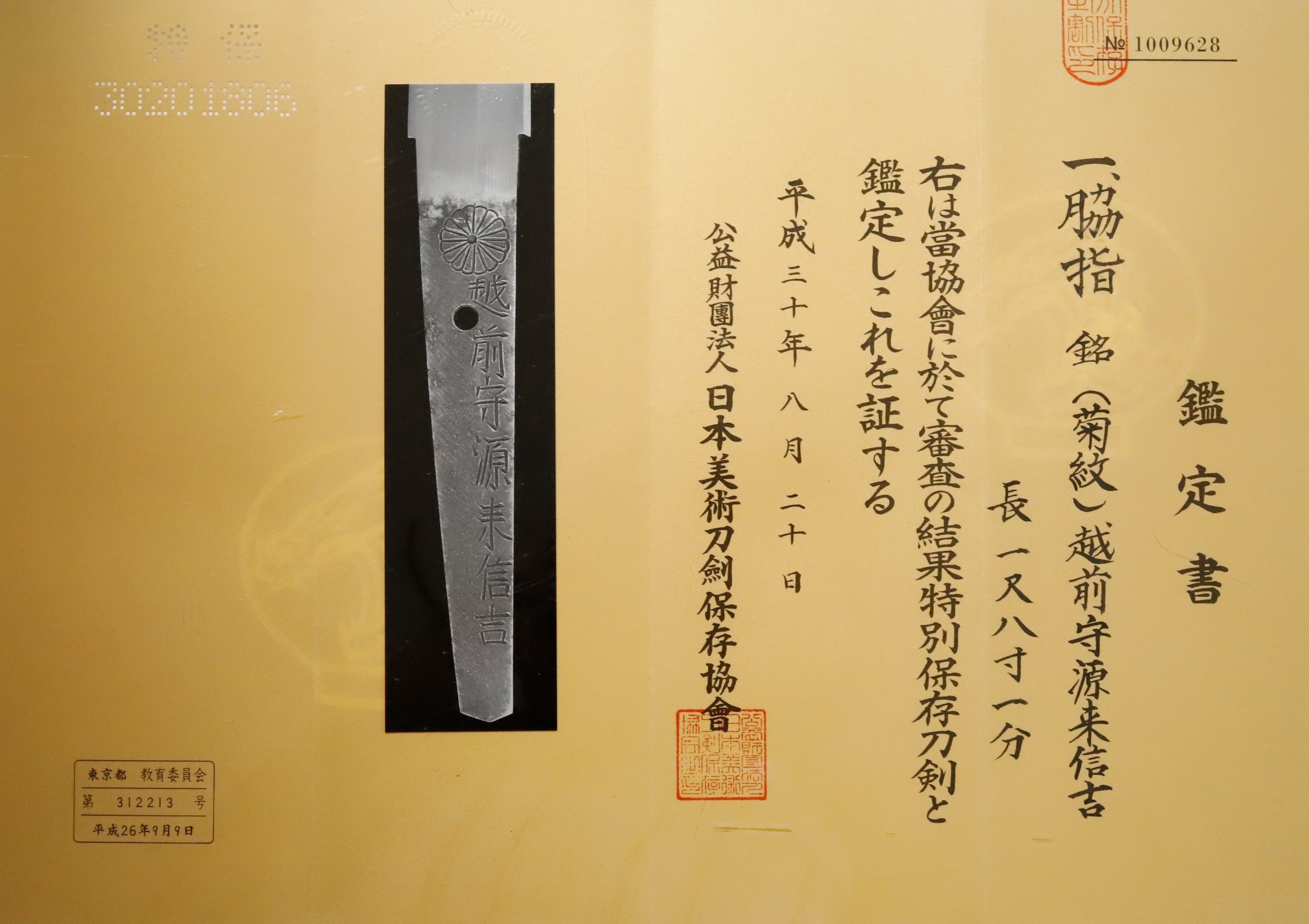
Registration Number : Tokyo 312213
The Board of Education in Tokyo prefecture issued a registration paper for this sword . In order to obtain this paper, the sword needs to be traditionally hand forged. With this paper, its owner can legally own an authentic Japanese sword in Japan. This paper will need to be returned to the board of education when the sword being shipped abroad but you can receive a copy of it.
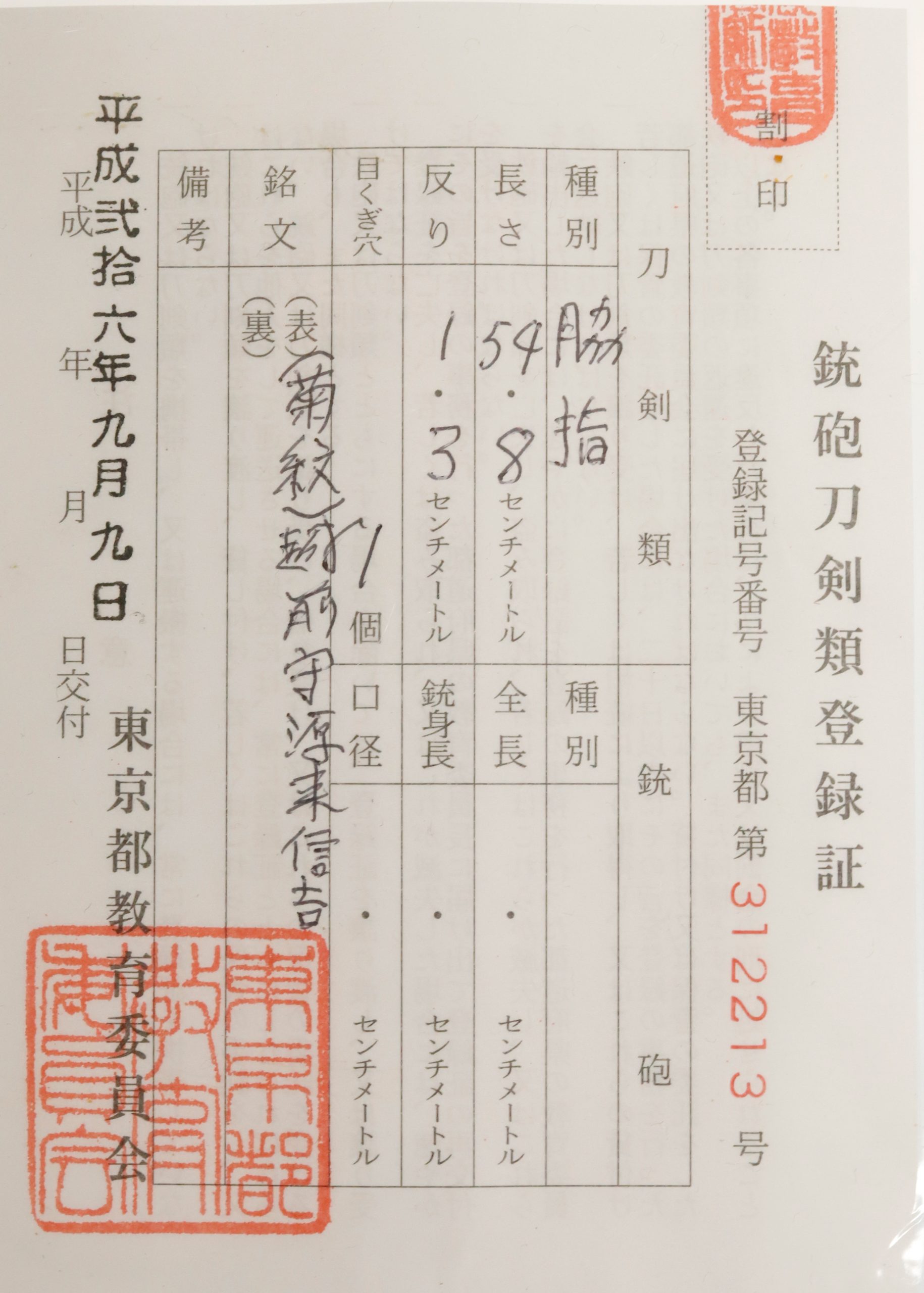
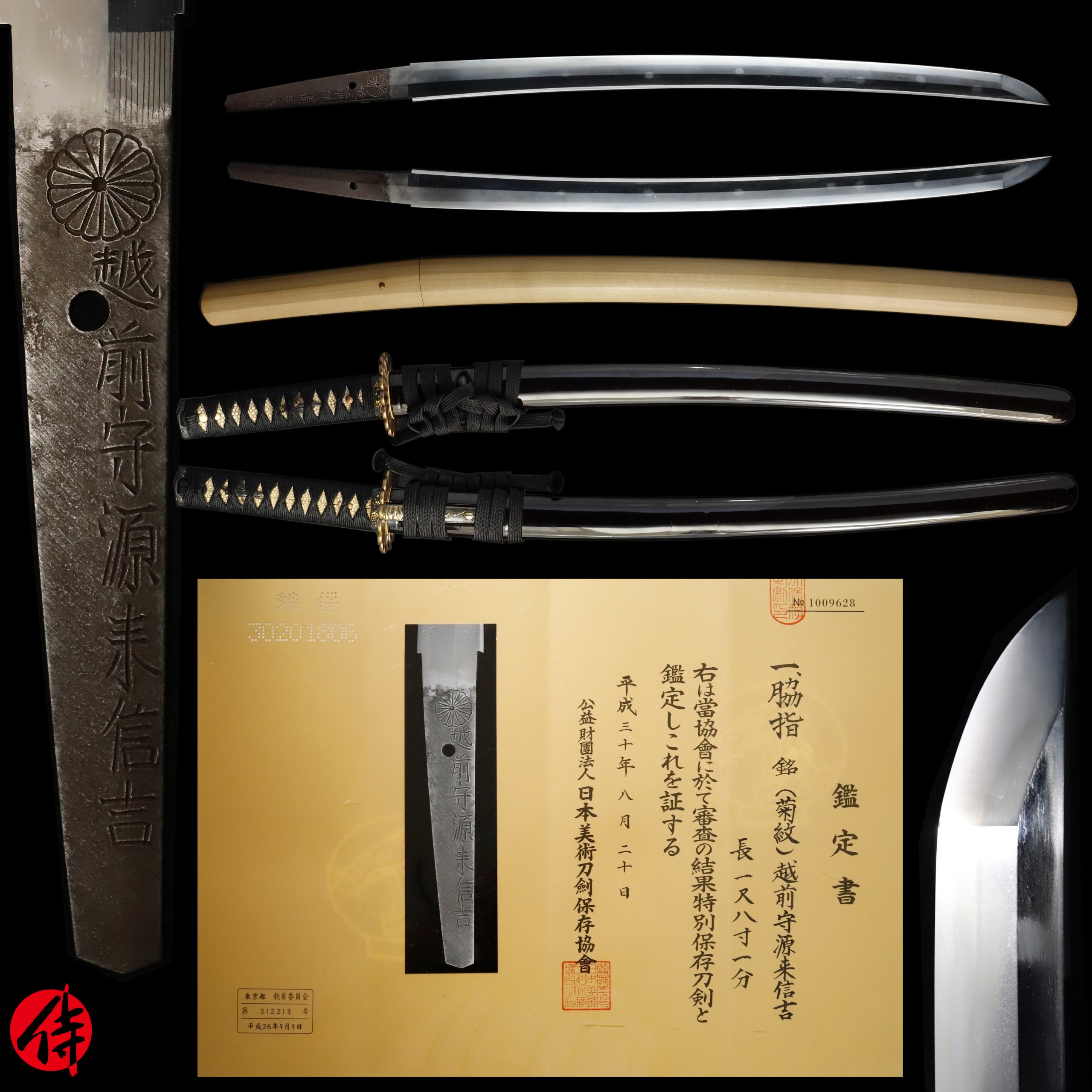
—————————————————————–
【About us】
Samurai Museum is located in Tokyo, Japan, exhibiting antique artifacts related to the Samurai history. Samurai Museum Shop is the place for those who are interested in Japanese culture and craftsmanship. We deal with antique Samurai swords/armor, traditional crafts made in Japan and so on.
【Japanese Sword& Export Process】
The Japanese swords we deal with are hand-forged edged swords made in Japan. It was made from the traditional carbon steel called TAMAHAGANE(玉鋼). Samurai Museum is familiar with the proper legal procedure for an antique/ authentic Japanese sword to be exported from Japan. We have sent more than 300 Japanese swords to amazing owners who appreciate its historical value.
Each Japanese sword is registered under the Agency for Cultural Affairs and the Board of Education in Japan.They issue a registration paper for each Japanese sword for its owner in Japan to legally possess it. The Japanese sword with its registration paper means it was traditionally hand-forged in Japan.
To legally export the sword from Japan to other countries, we will have to apply for its permit to the Agency for Cultural Affairs(Bunkacho) and return the original registration paper to the Board of Education. It normally takes around 2-4 weeks to receive this permit after submitting required documents. And we would like you to expect at least 1-1.5 months for your order to arrive at your given address after you ordered. For more detailed info, please click here.
It is allowed for residents in Japan to own authentic Japanese swords without a special license as long as they come with registration papers. Please feel free to contact us if you are a resident of Japan, whether temporarily or permanently. We will also assist you when you leave Japan and need to obtain the export permit.
【Payment Method】
We accept payment through Stripe(Credit card), PayPal, Apple Pay or ChromePay, all of which are secure payment methods. If you prefer other payment method, please contact us. After confirming your payment, we will apply for an export permit. You may either pay in JPY, USD, AUD, EUR or GBP. The price is set in Japanese Yen. Prices in other currencies are automatically calculated based on the latest exchange rate.

【Shipping】
We have shipped authentic Japanese swords to the USA, Canada, Mexico, Australia, UK, Germany , France and Hong Kong. If you don’t live in these countries and like to order, please contact us first before making a purchase. We offer Free International Shipping as long as we can send antique Japanese swords by either EMS or FedEx(Canada).
We normally ship by EMS(Express Mail Service) provided by Japan Post. When we receive an order from the Canada we will use FedEx instead as EMS temporarily stops shipping from Japan to those countries due to COVID-19.
We will send you a tracking number for your order as soon as we hand it to the post office/FedEx. We will put 100 % insurance on the shipping document without any extra charge. Based on the total amount, there might be a duty tax or other fee for you to pay, depending on the countries. We use package cushioning to protect the item and put it in a PVC pipe, which is one of the most secure packages because of its durability.
It will normally takes 5-14 days for the item to arrive at your given address after we dispatch it. Time of delivery is estimated as accurately as possible by the carrier but does not take into account any delays beyond our control such as by inclement weather, post office holiday seasons.
*Please keep in mind that due to the spread of COVID-19, there might be delays in shipping. If you like to know the detail about shipping, please feel free to ask us.

【How to make sure the condition】
Please keep in mind that what you are going to purchase is an antique item. We uploaded high resolution photos for you to check its condition thoroughly. If you like to see more photos with different angles, please feel free to contact us. We will be happy to send them to you so that you can make informed decision. It is essential for us to know that you are happy with your choice of a sword. and we are prepared to use the best of our ability to serve you.
【The Art of Nihonto(Japanese Sword)】
Samurai’s history is a profound, eloquent legacy of ancient Japanese warriors in which millions of people worldwide are being fascinated. If you like to find out the art of Nihonto, please click here.
【A Guide to Japanese Sword Maintenance】
After acquiring an genuine Japanese sword, it is also important to know how to take good care of it. Here is the special video for you. Mr. Paul Martin, Japanese sword expert, shows you how to give proper maintenance to your sword. When you purchase a Japanese sword from us, you can get a Free sword maintenance kit, which appears in this video.

